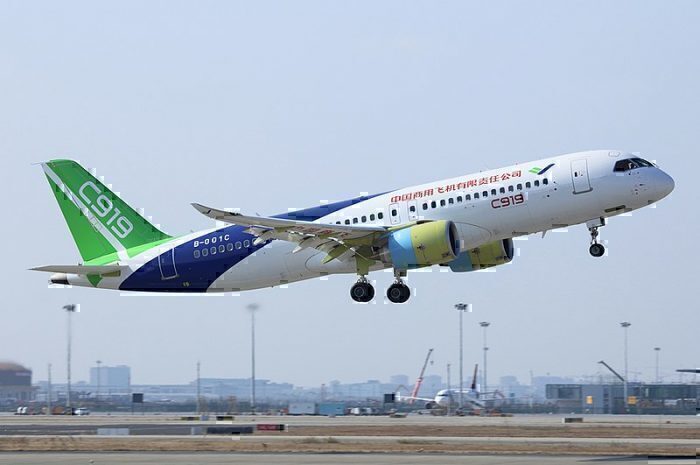Boeing and Airbus have long dominated the commercial aircraft market. Just take a look at the fleets of most airlines and you will see mostly Boeing and Airbus aircraft. There are potential new entrants to the market though – from Russia, China, and Japan – that may challenge this in the not too distant future.

Breaking up a dominated market
Since the 1990s at least Boeing and Airbus have dominated the passenger airline market. The main reasons for this are the high costs and barriers to entry in the market, and the long history and developed relationships with airlines and regulators.
Over the years, there has been plenty of potential competitors, from companies including Embraer, Bombardier, McDonnell Douglas, and Lockheed. But this has failed to prevent the formation of what is now regularly quoted as a major duopoly. Embraer is currently the third-largest manufacturer but is close to being acquired by Boeing.

There are some new aircraft appearing in recent years that may shake up this dominance. These are still small in terms of market penetration but set to grow over the coming years. With the right funding and pricing, they could become a challenge for the duopoly.
COMAC ARJ21
COMAC (Commercial Aircraft Corporation of China) was formed in 2008 as part of China’s growth in the aviation sector. Their first competitive commercial aircraft produced is the ARJ121. This is a 78 to 90 seat medium range narrowbody aircraft, with two rear-mounted General Electric engines., making it look very similar to the MD-80 aircraft.
The ARJ121 is now in operation with two Chinese airlines. There are also (as of August 2019) over 300 orders. These are mostly with Chinese domestic airlines, including the three largest – Air China, China Southern Airlines and China Eastern Airlines – which all announced purchases of 35 aircraft in August 2019.

COMAC C919
COMAC has taken things further with the larger C919 aircraft, first flown in May 2017. Often reported as a potential competitor to the Boeing 737 and Airbus A320 family, the C919 is a twin-engine narrow-body that can carry 158 passengers in two cabins, with a range of 4.075 kilometers.
The aircraft is still to enter commercial service, with only test prototypes currently flying. The launch was recently delayed by COMAC, and it could be another three years before we see it in service.
We took a look at the differences between the C919 and the A320 as well as the 737. There are some shortcomings, mainly in the lower range of the C919, but COMAC could well address this as development continues.

As was discussed in a recent Bloomberg article, the ongoing issues with the 737 and production delays with the A320, there could be a strong market for this replacement.
There are over 300 orders and a further 700 options for the C919. All of these are with Chinese airlines, apart from 10 ordered by General Electric. COMAC has strong ambitions though. According to an ATW Online article in 2017, “COMAC aims to take a fifth of the global narrowbody market and a third of the Chinese market by 2035.”
CRAIC 929
China is also developing aircraft in cooperation with Russia. This time it is a widebody competitor to Boeing and Airbus. CRAIC (China-Russia Commercial Aircraft International Corporation) was set up in 2016 as a joint venture based in China, between Chinese COMAC and Russian manufacturer UAC (United Aircraft Corporation).
Their first aircraft, known as the 929, is still under development but is expected to be an approximately 280 seat widebody aircraft with a range of over 7,500 miles.

It remains to be seen whether this will be take up just by Chinese and Russian airlines or will appeal globally (particularly if it is offered at a lower price point than Boeing and Airbus aircraft). We know though that CRAIC has set itself the goal of securing 10 percent of the widebody market over the next 20 years.
Irkut MC-21
Irkut is developing a narrowbody twinjet, with a capacity of between 132 and 163 passengers. It uses the same Pratt & Whitney engines as the Airbus A220 and has a range of over 6,000 kilometers. The MC-21 made its first flight in December 2019 and is expected to enter service in 2021.
As of summer 2019, Irkut claims to have 174 orders, including from Aeroflot, the Sakha Republic based Yakutia Airlines and Kazakhstan’s Bek Air.

This may be the first commercial aircraft development from Irkut (a branch of UAC). But the company already has experience manufacturing parts for the Airbus A320, and in military aircraft production.
Mitsubishi MRJ / Spacejet
The MRJ (Mitsubishi Regional Jet), renamed to Spacejet in 2019, is a series of narrowbody twin-engine jets. This came about as part of a Japanese government program (in 2003) to develop regional aircraft in Japan. There have been several delays, but the Spacejet is currently in final testing stages and delivery is expected later in 2020.

The concept could be appealing to many airlines. The smaller M100 aircraft is designed to overcome limitations in the US market, where pilot scope clauses limit the size of aircraft flown. As of August 2019, there were 213 orders and a further 194 options (for both the M100 and the smaller M90). This includes orders from US airlines SkyWest and Mesa Airlines, as well as Japanese ANA and JAL.
Which do you think has the potential to unseat Boeing and Airbus? Let us know in the comments.
[ad_2]
Source link


